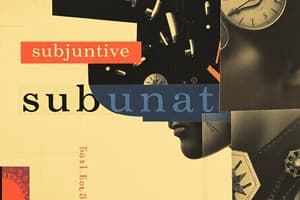Podcast
Questions and Answers
What mood is used to give direct commands or instructions?
What mood is used to give direct commands or instructions?
- Conditional (correct)
- Interrogative
- Subjunctive
- Indicative
Which mood is used to make statements and ask questions without any particular condition?
Which mood is used to make statements and ask questions without any particular condition?
- Subjunctive (correct)
- Imperative
- Conditional
- Interrogative
In which mood is the subject implied rather than explicitly expressed?
In which mood is the subject implied rather than explicitly expressed?
- Subjunctive (correct)
- Indicative
- Conditional
- Imperative
Which mood is used for suggestions, possibilities, doubts, or necessities?
Which mood is used for suggestions, possibilities, doubts, or necessities?
What mood is typically used in hypothetical situations or conditions that are contrary to fact?
What mood is typically used in hypothetical situations or conditions that are contrary to fact?
Which mood is most commonly used in everyday speech and writing?
Which mood is most commonly used in everyday speech and writing?
Which mood is used to express hypothetical or unlikely situations based on 'if' clauses?
Which mood is used to express hypothetical or unlikely situations based on 'if' clauses?
Which mood is used to convey commands in English?
Which mood is used to convey commands in English?
Flashcards are hidden until you start studying
Study Notes
Verb moods refer to different forms of verbs used depending on the function within a sentence. In English grammar, there are five moods: indicative, imperative, subjunctive, conditional, and interrogative. Each mood has its specific purpose and usage in constructing various types of sentences.
Indicative Mood
The indicative mood is used to make statements, ask questions, or express commands without any particular condition. It's the most commonly used verb mood in everyday speech and writing. For example, "I walk every day." or "She sings beautifully" would both be written using the indicative mood.
Imperative Mood
The imperative mood is used to give direct commands or instructions. Unlike the indicative mood, it does not require an auxiliary verb such as 'do' or 'does'. Instead, the subject is implied rather than expressed explicitly. For instance, "Run!" is an imperative command. This mood is also used when addressing someone formally, such as "Please step into my office.".
Subjunctive Mood
The subjunctive mood is used to suggest possibility, doubt, or necessity for a certain action or situation. Two main ways to form subjunctive constructions are through the use of "wish" clauses, where the verb starts with "were", and by stating what could happen if something were true. For example, "If I were a bird, I would fly." This mood is often used in hypothetical situations or conditions that are contrary to fact.
Conditional Mood
The conditional mood is used to express hypothetical or unlikely situations based on "if" clauses. In English, the conditional mood can be expressed using various tenses: simple present for past conditions and simple future for present conditions. For example, "If I have an apple, I eat it." or "If it rains, we will stay at home." Both these sentences are written using the conditional mood.
Interrogative Mood
Lastly, the interrogative mood is used to ask questions, as evident from its name. It requires an auxiliary verb such as 'do', 'does', 'did', or 'have' followed by the main verb in its base form. The subject and object pronouns change depending on who is performing the action. An example of this would be "Do you know what time it is?" or "Did he finish his homework?" These sentences all use the interrogative mood.
Studying That Suits You
Use AI to generate personalized quizzes and flashcards to suit your learning preferences.




